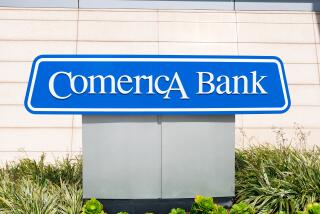S&Ls; Lose Record $10.7 Billion of Deposits in Month
- Share via
WASHINGTON — The nation’s savings and loan institutions lost a record $10.7 billion in deposits in January, more than in any previous full year in the industry’s history, the Federal Home Loan Bank Board reported Tuesday.
The huge outflow, which affected 80% of the nation’s 2,945 thrifts, followed an $8.3-billion deposit hemorrhage in December, which brought the total for all of 1988 to $8.6 billion. James Barth, the bank board’s chief economist, said a preliminary estimate shows that another $8 billion to $9 billion in withdrawals were likely to have hit the industry in February.
Less than two weeks ago, board officials gave much lower estimates, saying that preliminary figures showed withdrawals to have been $7 billion in January and $3.7 billion for the first 20 days of February.
On Tuesday, Barth laid the blame for the outflow not on the industry’s financial crisis but on the fact that depositors found higher interest rates in money market funds and other investments than S&Ls; were offering.
The huge loss of deposits--nearly $30 billion over the last three months--comes at a critical time for the embattled thrifts.
President Bush’s proposed plan to bail out depositors of some 350 insolvent but federally insured S&Ls; relies heavily on revenue from the deposit insurance fee that the government charges healthy thrift institutions. The Bush plan assumes a growing stream of revenue from an expanding pool of deposits at S&Ls.;
Meanwhile, Congress’ General Accounting Office criticized last year’s hurry-up mergers and sales of nearly 200 S&Ls; as far more costly to U.S. taxpayers than has been estimated by the bank board, which arranged the deals.
In one-third of the cases, the GAO estimated, it would have been cheaper simply to close the insolvent institutions and pay off the depositors.
Republicans Object
Testifying to the Senate Banking, Housing and Urban Affairs Committee, Comptroller General Charles A. Bowsher said his estimate is based on an in-depth survey of a dozen of the largest of the 179 mergers crammed into the last weeks of 1988 to beat a Dec. 31 expiration deadline on tax breaks that made the mergers more attractive to potential buyers of insolvent S&Ls.;
Committee Republicans, led by Sen. Jake Garn of Utah, objected that the GAO criticism ignored the fact that congressional Democrats for two years had refused to approve increased funding for the Federal Savings and Loan Insurance Corp., the arm of the Federal Home Loan Bank Board that insures S&L; deposits. More money in FSLIC’s hands, the Republicans said, would have made more liquidations possible.
Brushing aside those objections, Bowsher said FSLIC had grossly underestimated the cost of the tax breaks that made the December deals attractive. He said the total cost of the buyouts would run to $37 billion, instead of the previously estimated $28.4 billion.
Bowsher also complained that the hurriedly arranged deals were incompletely documented, so that the full details of bidding procedures were unclear to GAO accountants.
Bowsher complained that some successful bidders appear likely to recapture their investments in as little as three years and that the reorganized thrifts, as yet unaudited, would prove to be seriously undercapitalized.
Big Profits Seen
After hearing these criticisms, committee Chairman Donald W. Riegle (D-Mich.), a longtime supporter of the S&L; industry, suggested that unspecified “inside track” deals and “a pattern of favoritism” may have benefited some bidders over others.
“Who got rich?” Riegle demanded. “These are very troubling appearances, to say the least. . . . We intend to get to the bottom of it (and find out) if there has been a pattern of favoritism to (bidders on the) inside track.” In reporting on the huge outflow of deposits from S&Ls; during January, the bank board’s Barth said “less than half” of the withdrawals were provoked by “confidence problems” and by widespread press reports early this year that the Bush Administration was considering a direct tax on S&L; deposits.
Rather, Barth said, the main reason for the huge outflow of funds was purely economic: Better interest rates are available almost any place else.
More to Read
Inside the business of entertainment
The Wide Shot brings you news, analysis and insights on everything from streaming wars to production — and what it all means for the future.
You may occasionally receive promotional content from the Los Angeles Times.










